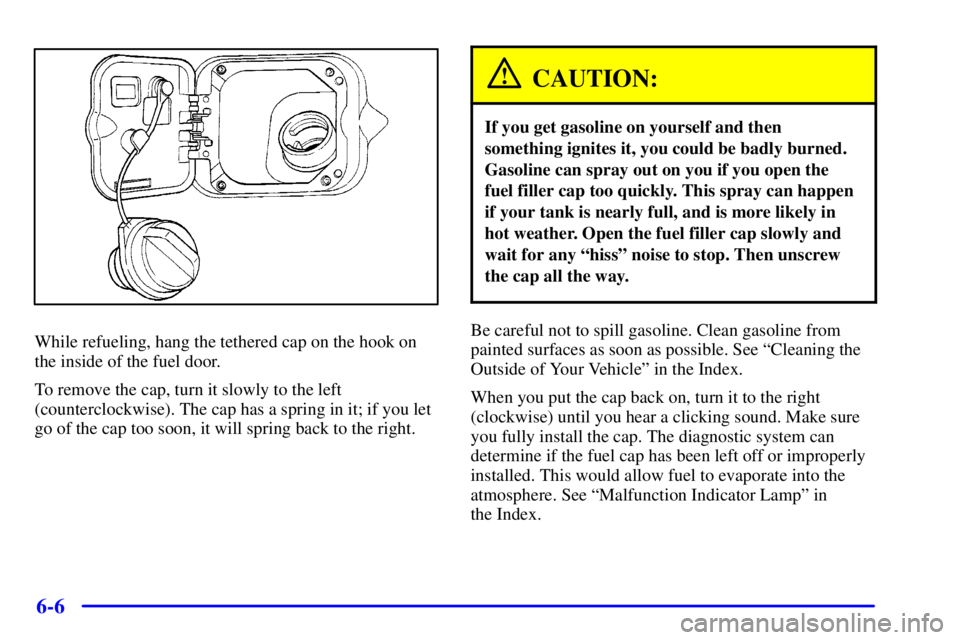Page 191 of 402

3-31
PUSHBUTTONS: The six numbered pushbuttons let
you return to your favorite Program Types (PTYs).
These buttons have factory PTY presets. You can set up
to 12 PTYs (six FM1 and six FM2). Just:
1. Press PROG
-TYPE, if it is not already on.
2. Press AM
-FM to select FM1 or FM2.
3. Turn the SELECT knob to select a PROG
-TYPE.
4. Press and hold one of the six numbered buttons until
you hear a beep. Whenever you press that numbered
button, the PTY you set will return.
5. Repeat the steps for each pushbutton.
ALERT!: This type of announcement warns of national
or local emergencies. You will not be able to turn off
alert announcements. ALERT! appears on the display
when an alert announcement plays. When an alert
announcement comes on the tuned radio station, you
will hear it, even if the volume is muted or a cassette
tape or compact disc is playing. If the cassette tape or
compact disc player is playing, play will stop for the
announcement and resume when the announcement
is finished.ALTERNATE FREQUENCY: This feature allows the
radio to switch to a stronger station with the same
program type. Press and hold AM
-FM for two seconds
to turn alternate frequency on. AF ON will appear on the
display. The radio may switch to stronger stations. Press
and hold AM
-FM again for two seconds to turn alternate
frequency off. AF OFF will appear on the display. The
radio will not switch to other stations.
Adjusting the Speakers
BAL
-FADE: This button adjusts balance and fade.
To adjust balance, press this button until BAL appears
on the display. Turn the SELECT knob clockwise for
the right speakers and counterclockwise for the left
speakers. The middle position balances the sound
between the speakers. To adjust fade, press this button
until FAD appears on the display. Turn the SELECT
knob clockwise to adjust the sound to the front speakers
and counterclockwise for the rear speakers. The middle
position balances the sound between the speakers. Press
and hold this button for two seconds to return both fade
and balance to the middle position.
Page 192 of 402

3-32
Playing a Cassette Tape
Your tape player is built to work best with tapes that are
up to 30 to 45 minutes long on each side. Tapes longer
than that are so thin they may not work well in this
player. The longer side with the tape visible should face
to the right. If the ignition is on, but the radio is off, the
tape can be inserted and will begin playing. If you hear
nothing but a garbled sound, the tape may not be in
squarely. Press EJECT to remove the tape and start over.
While the tape is playing, use the VOL, FAD, BAL,
TREB, MID, BASS, EQ, SEEK and SCAN controls just
as you do for the radio. The display will show TAPE and
an arrow showing which side of the tape is playing. The
tape player automatically begins playing the other side
when it reaches the end of the tape.
Your tape bias is set automatically when a metal or
chrome tape is inserted. If you want to insert a tape
when the ignition is off, first press EJECT or the
RCL knob.
If an error appears on the radio display, the tape won't
play because of an error.TIGHT TAPE is displayed when the tape is tight and the
player can't turn the tape hubs. Remove the tape. Hold
the tape with the open end down and try to turn the right
hub counterclockwise with a pencil. Turn the tape over
and repeat. If the hubs do not turn easily, your tape may
be damaged and should not be used in the player. Try a
new tape to make sure your player is working properly.
BROKEN TAPE is displayed when the tape is broken.
Try a new tape.
WRAPPED TAPE is displayed when the tape is
wrapped around the tape head. Attempt to get the
cassette out. Try a new tape.
If any error occurs repeatedly or if an error can't be
corrected, please contact your dealer. If your radio
displays an error message, write it down and provide it
to your dealer when reporting the problem.
FWD (1): Press this button to advance quickly to
another part of the tape. Press the button again to return
to playing speed. The radio will play the last selected
station while the tape advances. You may select stations
during FWD operation by using TUNE.
While in FWD mode the display will show FREQ and
FWD��. If the radio is playing a RDS station the
display will only show FREQ.
Page 216 of 402

4-12 Steering in Emergencies
There are times when steering can be more effective
than braking. For example, you come over a hill and
find a truck stopped in your lane, or a car suddenly pulls
out from nowhere, or a child darts out from between
parked cars and stops right in front of you. You can
avoid these problems by braking
-- if you can stop in
time. But sometimes you can't; there isn't room.
That's the time for evasive action
-- steering around
the problem.
Your vehicle can perform very well in emergencies like
these. First apply your brakes. (See ªBraking in
Emergenciesº earlier in this section.) It is better to
remove as much speed as you can from a possible
collision. Then steer around the problem, to the left or
right depending on the space available.
An emergency like this requires close attention and a
quick decision. If you are holding the steering wheel at
the recommended 9 and 3 o'clock positions, you can
turn it a full 180 degrees very quickly without removing
either hand. But you have to act fast, steer quickly, and
just as quickly straighten the wheel once you have
avoided the object.
The fact that such emergency situations are always
possible is a good reason to practice defensive driving
at all times and wear safety belts properly.
Page 259 of 402
5-16 How to Add Coolant to the Radiator
1. You can remove the radiator pressure cap when the
cooling system, including the radiator pressure cap
and upper radiator hose, is no longer hot. Turn the
pressure cap slowly counterclockwise until it first
stops. (Don't press down while turning the
pressure cap.)
If you hear a hiss, wait for that to stop. A hiss means
there is still some pressure left.
2. Then keep turning the pressure cap, but now push
down as you turn it. Remove the pressure cap.
Page 266 of 402
5-23 Removing the Flat Tire and Installing the
Spare Tire
1. Use the wheel wrench to loosen the wheel nuts, but
don't remove them.
2. Turn the wheel wrench counterclockwise to lower
the jack lift head until it fits under the vehicle.
Page 268 of 402
5-25
4. Raise the vehicle by turning the wheel wrench
clockwise. Raise the vehicle far enough off the
ground so there is enough room for the spare tire
to fit.
5. Remove all the wheel nuts and take off the flat tire.
6. Remove any rust or dirt
from the wheel bolts,
mounting surfaces and
spare wheel.
CAUTION:
Rust or dirt on the wheel, or on the parts to
which it is fastened, can make the wheel nuts
become loose after a time. The wheel could come
off and cause an accident. When you change a
wheel, remove any rust or dirt from the places
where the wheel attaches to the vehicle. In an
emergency, you can use a cloth or a paper towel
to do this; but be sure to use a scraper or wire
brush later, if you need to, to get all the rust or
dirt off.
Page 269 of 402
5-26
CAUTION:
Never use oil or grease on studs or nuts. If you
do, the nuts might come loose. Your wheel could
fall off, causing a serious accident.
7. Place the compact spare tire on the
wheel
-mounting surface.
8. Then reinstall the wheel
nuts with rounded end
of the nuts toward
the wheel.
Make sure each wheel bolt is centered in each wheel
hole while tightening the nuts. Tighten each nut by
hand until the wheel is held against the hub.
9. Lower the vehicle by turning the wheel wrench
counterclockwise. Lower the jack completely.
Page 281 of 402

6-6
While refueling, hang the tethered cap on the hook on
the inside of the fuel door.
To remove the cap, turn it slowly to the left
(counterclockwise). The cap has a spring in it; if you let
go of the cap too soon, it will spring back to the right.
CAUTION:
If you get gasoline on yourself and then
something ignites it, you could be badly burned.
Gasoline can spray out on you if you open the
fuel filler cap too quickly. This spray can happen
if your tank is nearly full, and is more likely in
hot weather. Open the fuel filler cap slowly and
wait for any ªhissº noise to stop. Then unscrew
the cap all the way.
Be careful not to spill gasoline. Clean gasoline from
painted surfaces as soon as possible. See ªCleaning the
Outside of Your Vehicleº in the Index.
When you put the cap back on, turn it to the right
(clockwise) until you hear a clicking sound. Make sure
you fully install the cap. The diagnostic system can
determine if the fuel cap has been left off or improperly
installed. This would allow fuel to evaporate into the
atmosphere. See ªMalfunction Indicator Lampº in
the Index.